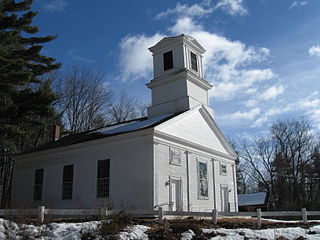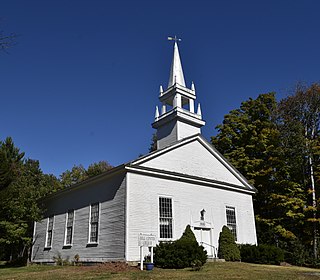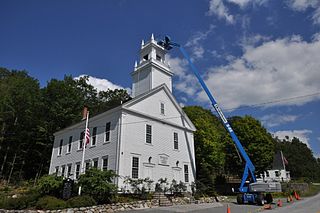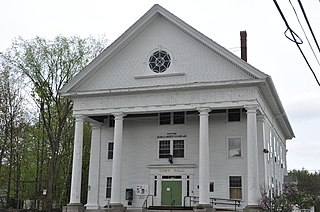
The Bay Meeting House and Vestry, now the Second Baptist Church, is a historic church complex on Upper Bay and Steele Roads in Sanbornton, New Hampshire. Built in 1836 for a Free Will Baptist congregation headed by Moses Cheney, the church is a good example of transitional Federal and Gothic Revival architecture. It was listed on the National Register of Historic Places in 1984.

The Centre Congregational Church is a historic Congregational church on Province Road in Gilmanton, New Hampshire. Built in 1826–27, it is one of the region's best examples of a late Federal-period church. It was listed on the National Register of Historic Places in 1983.

The First Baptist Church of Gilmanton, also known as the Lower Gilmanton Church, is a historic church building on Province Road, slightly north of Stage Road, in Gilmanton, New Hampshire. Built in 1842, the church is one of Belknap County's finest Greek Revival churches, and is accompanied by the county's most intact 19th-century horsesheds. The property was listed on the National Register of Historic Places in 1989.

The First Free Will Baptist Church in Meredith is a historic church building at 61 Winona Road in Meredith, New Hampshire, United States. Built about 1802 and remodeled in 1848, it is a good example of a mid-19th century vernacular Greek Revival rural church. It is now a museum called the Pottle Meeting House, managed by the local historical society. The building was listed on the National Register of Historic Places in 1986.

The Early Settlers Meeting House is a historic church building at the junction of Granite and Foggs Ridge roads at Leighton Corners in the town of Ossipee, New Hampshire, United States. Built in the 1810s for a Free Will Baptist congregation and remodeled in 1856, it is a well-preserved example of a vernacular mid-19th century church. Now owned by the Ossipee Historical Society, the building was listed on the National Register of Historic Places in 1995.

The First Congregational Church of Boscawen is a historic church at 12 High Street in Boscawen, New Hampshire. Built in 1799, the wood-frame church was significantly altered in 1839, when it acquired its present Greek Revival character. It is one of the few surviving meeting houses in New Hampshire that continues to combine religious and municipal functions; it basement space is used for town meetings and elections. The building was listed on the National Register of Historic Places in 1982.

The Hill Center Church is a historic church on Murray Hill Road in Hill, New Hampshire. Built in 1799 and extensively altered in 1847, it is a well-preserved example of Gothic Revival architecture, used historically for both religious and civic functions in the town. Now maintained by a local community group, the building was listed on the National Register of Historic Places in 1985.

The New Durham Meetinghouse and Pound are a historic colonial meeting house and town pound on Old Bay Road in New Durham, New Hampshire. Built in 1770, the wood-frame meeting house stands at what was, until about 1850, the center of New Durham, and was originally used for both civic and religious purposes. Now a public park, the property was listed on the National Register of Historic Places in 1980.

The Springfield Town Hall and Howard Memorial Methodist Church, also known as the Springfield Union Meeting House, is a historic civic and religious building on Four Corners Road in Springfield, New Hampshire. Built about 1797 and restyled in 1851, it is a rare surviving example in the state of a meeting house whose functions include both civic and religious uses. It is also a good example of Greek Revival and Gothic architecture, and was listed on the National Register of Historic Places in 1986.

The Starksboro Village Meeting House is a historic church and town hall on Vermont Route 116 in the village center of Starksboro, Vermont. It was built in 1838 as a cooperative venture between three church congregations and the town, and is a fine local example of Gothic Revival architecture. It was listed on the National Register of Historic Places in 1985.

The New Hampton Town House is a historic meeting house at the junction of Town House Road and Dana Hill Road in New Hampton, New Hampshire. Since 1799, it has served as the community's town hall, and is one of three surviving 18th-century town halls in Belknap County still used for that purpose. It was added to the National Register of Historic Places in 1998.

The Old Webster Meeting House is an historic meeting house at 1220 Battle Street in Webster, New Hampshire. Built in 1791, and altered in the 1840s, the meeting house is one of a small number of 18th-century meeting houses to survive in northern New England. The building was moved from its original site in 1942 to make way for a flood control project and was given modern footings for the granite foundation in 1979. The building, owned by the Society for the Preservation of the Old Meeting House, now serves as a local museum. It was listed on the National Register of Historic Places in 1985.

The Bedford Town Hall is located at 70 Bedford Center Road in Bedford, New Hampshire. Built in 1910, it is a prominent early work of Chase R. Whitcher, a noted architect of northern New England in the early 20th century. The building is the third town hall to stand on this site, and was listed on the National Register of Historic Places in 1984.

The Lord's Hill Historic District encompasses a historic village center in Effingham, New Hampshire. Located along New Hampshire Route 153 on a hill in northern Effingham, it is a well-preserved late 18th and early 19th-century rural village. It is named for Isaac Lord, a leading figure in its development in the early 19th century. The district was listed on the National Register of Historic Places in 1985.

The Kensington Town House is the town hall of Kensington, New Hampshire. Located at 95 Amesbury Road, the single-story wood-frame building was erected in 1846, and has been its only purpose-built municipal hall. It is a good local example of civic Greek Revival architecture, and its hall has historically hosted town meetings and social functions. The building was listed on the National Register of Historic Places in 2013.

The Union Meetinghouse or Universalist Church is a historic church building at 97 Amesbury Road in Kensington, New Hampshire. Built in 1839–40, it is a well-preserved and little-altered example of a mid-19th century Greek Revival rural church. It was listed on the National Register of Historic Places in 2013, and continues to be used for summer services.

The Washington Common Historic District encompasses a cluster of three civic buildings and the town common in the center of Washington, New Hampshire. The town common began as a 2-acre (0.81 ha) parcel acquired in 1787, and the current town hall followed in 1789. It is a two-story wood-frame building which originally served as both a civic and religious meeting house. The adjacent Gothic Revival Congregational Church was built in 1840. The third structure is the Schoolhouse, a 2+1⁄2-story two-room school built in 1883. The district was listed on the National Register of Historic Places in 1986.

Gilmanton Academy is a historic school building on Province Road in Gilmanton, New Hampshire. Built in 1894, it is a well-preserved example of a 19th-century academy building, and was one of the last to be built in the state. The building, now housing town offices and the local historical society, was listed on the National Register of Historic Places in 1983.

The Gilmanton Ironworks Library is a historic library building at 10 Elm Street in the Iron Works village of Gilmanton, New Hampshire. Built in 1916–17, it was the first Colonial Revival library building in Belknap County. The building, still serving as a branch of the Gilmanton public library system, was listed on the National Register of Historic Places in 1989.

The Milton Town House is a historic civic and religious building at the junction of Town House Road and New Hampshire Route 125 in Milton, New Hampshire. Built in 1803 as a meeting place for civic and religious uses, it has served as Milton's town meeting site since then. It ceased religious functions in 1855, when it was reduced to a single story. The building was listed on the National Register of Historic Places in 1980.























